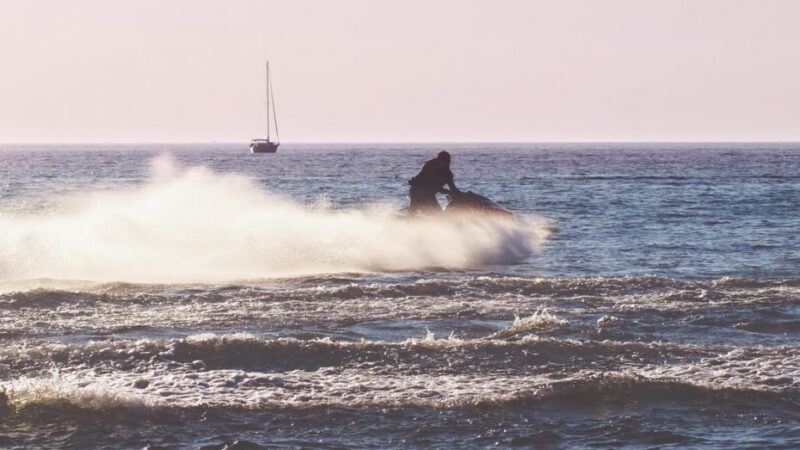Imagine: It’s a hot summer day, and you’re surfing behind a boat as it cuts across the lake.
But this isn’t water skiing. You’re not being pulled by a rope tied to the boat. You’re riding a perfectly curled wake, created by the boat itself.
That’s wakesurfing, a relatively new water sport that’s been gaining popularity on Minnesota lakes.
But while they’re showing up on more and more lakes, wakesurfing boats also have detractors, who say they’re eroding shorelines, affecting water quality and disturbing other lake users.
Wakesurfing boats have a specially designed hull to create a large wake, and a ballast tank that can be filled with water to add extra weight to create that perfect curl.

Wakesurfing boards sit in the bow of a wakeboat Friday on Lake Minnetonka in Mound.
Christine T. Nguyen | MPR News
“These boats just have a vastly larger capacity to have an impact, because they make more wake,” said Jeff Forester, executive director of the nonprofit Minnesota Lakes and Rivers Advocates.
Contemporary wakesurfing caught on nearly a decade ago. Since then, it’s exploded. Wake boats are now one of the fastest-growing segments of the powerboat industry.
“It’s been kind of a growing sport for a long time,” said Scott Nowak, a sales consultant for MarineMax in Excelsior.
Nowak said wakesurfing is appealing because it’s a low-impact activity that almost anyone can do.

A wakeboat pulls away from a dock on Lake Minnetonka. Opponents of wakesurfing believe that the waves created by the boats cause erosion along the lakeshore.
Christine T. Nguyen | MPR News
“Families can all do it,” he said. “When you have a 50-year-old dad with his kid, it’s a sport they can all do and still be walking after the weekend.”
Andy Weigman, who organizes annual wakesurfing championships on Lake Minnetonka, said part of the sport’s appeal is that the boat travels about 10 or 11 mph, roughly half the speed of boats used for water skiing.
The surfer also stays much closer to the back of the boat than a water skier, Weigman said, “so you can talk to your family and friends while you’re out on the water, and get heckled if you miss a trick.”
But some residents say the boats and their large wakes are just too much for smaller lakes.
“These waves are three to four times as powerful as skiing or wakeboarding or tubing,” said JoAnn Syverson, who lives on Lotus Lake near Chanhassen.
Syverson said she often sees waves from wakeboats crashing into the shore on her small lake. She worries they’re contributing to erosion along the lakeshore and stirring up sediment at the bottom of the lake.
“These boats increased in number, and suddenly our lake had clarity that was really bad and more weeds and algae,” Syverson said.

Scott Nowak, sales consultant for MarineMax in Excelsior, drives a Nautique G25 as Noah Flegel wakesurfs behind the boat last week on Lake Minnetonka. Boat speeds for wakesurfing range from 10 to 12 mph.
Christine T. Nguyen | MPR News
Syverson is part of a growing chorus of lake residents complaining that wake boats are having a negative impact.
She and others started a group, called Safe Wakes for Small Lakes, calling for wake boat restrictions. They say large wakes have knocked over small children and have made it scary to be in a kayak or canoe.
“My dock is damaged,” said Donna Burt, another Lotus Lake resident. “We’ve had to put our boat up on a lift. We are losing (shoreline) vegetation that is just falling into the lake.”
Hiding lake invaders?
There’s also fear that the ballast tanks in wake boats could harbor aquatic invasive species and spread them to new lakes or rivers.
In a two-year study for the Minnesota Aquatic Invasive Species Research Center, researcher Adam Doll collected and analyzed water samples from different compartments of boats on Lake Minnetonka and Gull Lake near Brainerd.
Doll, who is watercraft inspection coordinator for the Minnesota Department of Natural Resources, found that wake boats often had a few liters of residual water left over in their ballast tank after they’d been drained, as state law requires after leaving a lake.
The majority of the samples contained at least one zebra mussel veliger, or larva. Most of those larvae that were found alive died within 48 hours, Doll said.
“If you’re using a wake boat and you’re taking it to another body of water — let’s say within a week — it’s a good idea to try and flush those tanks out,” he said.
The study led to the American Boat and Yacht Council adopting recommended design changes for boat manufacturers last year aimed at making boats easier to drain and with fewer places for invasive species to hide.
‘Behavior issue’
The boat industry is aware of the pushback against wake boats, and has launched a campaign aimed at getting boaters to “wake responsibly.”
“We don’t have a wake issue. We have a behavior issue with young captains,” said Larry Meddock, chair of the Water Sports Industry Association, which represents about 400 manufacturers of tow boats and equipment.
Meddock said they’re encouraging boaters to be respectful, keep away from shore, avoid repetitive passes and turn down the music. He said if the boats stay at least 200 feet from shore, the waves are substantially reduced by the time they reach shore.

Professional wakesurfer Jodi Grassman surfs behind a wakeboat last week on Lake Minnetonka in Mound.
Christine T. Nguyen | MPR News
But that doesn’t satisfy the sport’s critics. They say the state needs to enact regulations on wake boats to keep them farther away from shore and off smaller lakes altogether.
“This is a huge issue for Minnesota, and for our lakes and rivers,” said Chuck Becker, who lives on Big Sugarbush Lake in Becker County. “Something has to be done.”
Weigman said with any sport, there will always be a small group of people who either ignore the rules, or aren’t aware of them.
“Most of us are pretty responsible and we stay far enough shore,” Weigman said. “We think it’s an education problem, not a wake boat problem.”





Recent Comments